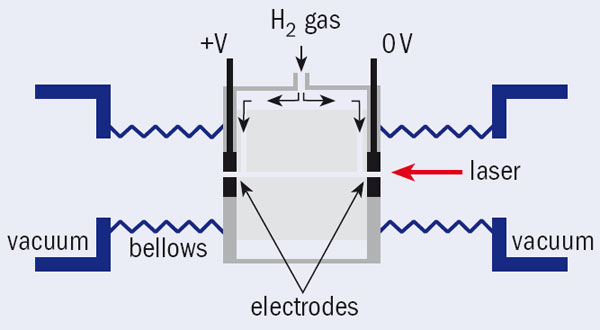Researchers at the Lawrence Berkeley National Laboratory (LBNL), together with colleagues from the University of Oxford , have accelerated electrons to more than 1 GeV in only 3.3 cm. This is the highest energy achieved with laser-wakefield acceleration, which harnesses the electric field of a plasma wave driven by a laser beam. Nature Physics have published the results (W P Leemans et al. 2006).

In laser-wakefield acceleration, a laser pulse travelling through a plasma excites plasma waves in its wake, setting up electric fields that accelerate electrons from the plasma. This produces accelerating gradients of 10–100 GV m-1, compared with 10–50 MV m-1 for radio-frequency-based systems, but it has proved difficult both to sustain the laser-wakefield acceleration over the distances needed to reach energies greater than about 100 MeV and to control the energy spread. About two years ago, however, Leemans and colleagues in the Laser Optics and Accelerator Systems Integrated Studies (L’OASIS) group at LBNL, and two other teams in France and the UK, reported using intense laser pulses in millimetre-length gas jets to reach energies of 70–200 MeV with much-reduced energy spreads (see CERN Courier November 2004 p5).

The teams in Europe used laser pulses of 30 TW with relatively large spot sizes to produce sufficiently long laser–plasma interaction lengths in the gas jet. The L’OASIS group developed an alternative solution by creating a plasma density channel in the gas jet to guide the laser drive pulse. An igniter pulse forms a narrow channel of plasma, which is shaped by a heater pulse to create a guide channel for the final drive pulse. Using this method in hydrogen gas, the L’OASIS team reached around 80 MeV with a drive pulse of just 9 TW in a channel 2 mm long.
To achieve higher energies with these techniques implies using petawatt lasers or channelling over longer distances. However, the latter option at first seemed limited. One problem in wakefield acceleration is that the electrons tend to outrun the wake, limiting the length of the accelerator and hence the energy reached. This limiting distance, called the dephasing length, can be increased by lowering the plasma density, but the formation of the plasma guide channel by the igniter-heater method becomes less efficient at lower densities.
The solution emerged when Leemans met Simon Hooker from Oxford University and discovered that Hooker’s group was using capillary guide channels in sapphire. Now the groups have joined forces and built a system that accelerates electrons for centimetres rather than millimetres.
The capillary is laser-machined in two halves in the faces of two blocks of sapphire, which are fixed together to form a thin tube 3.3 cm long. Hydrogen gas then flows in through other slots to fill the tube. A high-voltage discharge across the capillary both turns the hydrogen gas into plasma and heats it, creating a low-density region along the centre. When a laser drive pulse passes through this channel, the wakefield accelerates the plasma electrons.
The team has measured the energy of the bunches of electrons leaving the capillary accelerator using a 1.2 T spectrometer, which deflects the electrons onto a phosphor screen that is viewed by a CCD camera. With drive pulses of 12 TW, density of 3.5 × 1018 cm-3 and a capillary 225 μm in diameter, the researchers reliably produce a 0.48 GeV beam with an energy spread of less than 5% rms. Increasing the diameter to 310 μm and the power to 40 TW (density 4.3 × 1018 cm-3), yields a 1 GeV beam with spread of 2.5% rms, although the performance is less stable.
Leemans and his colleagues are now looking at injecting particles into the capillary, which may help with stability, and increasing the energy by “staging” sequential capillary sections. They are also considering what will be needed to reach 10 GeV.
Further reading
W P Leemans et al.2006 Nature Physics 2 699.







